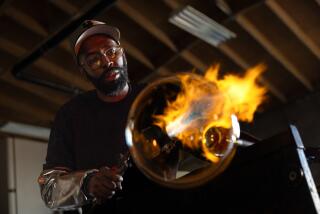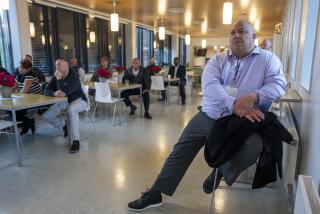Norway Art Company Makes It Crystal Clear
JEVNAKER, Norway — Norwegians love fine handblown glass and have high regard for the artists who design and create it.
Hadeland Glassworks--a complex containing factory, glass museum and outlet store--attracts thousands of Norwegians and foreign tourists to Jevnaker, a quiet town on the wooded shores of Randsfjorden Lake, 44 miles north of Oslo.
Founded in 1762, Hadeland is Norway’s oldest glassworks. The factory makes only handblown glass--a total of about 2 million sparkling objects each year. The products are sold at 105 shops throughout Norway, but foreign distribution is limited.
Although not readily available in the United States, Hadeland’s Peer Gynt full-lead crystal glasses are in the cupboards at the White House (they were added during the Johnson Administration). The Kennedy Center’s magnificent chandelier designed by Jonas Hilde is a Hadeland piece.
The Hadeland factory shop is well-stocked with about 35 different patterns of glasses. Each pattern has several styles of stemware and tumblers for wine, cocktails, champagne and beer. Also sold are carafes, vases and bowls made in grades from ordinary glass to full-lead crystal.
There is also a series of gleaming crystal figures of polar bears, arctic foxes, cats, snow owls, puffins and other creatures, as well as magnificent art-glass pieces designed by Hadeland’s master artists.
First-quality items are priced the same as Hadeland products elsewhere in Norway, but there are often special sales of 20% or 25% off selected merchandise, as well as fantastic bargains on seconds with barely perceptible flaws. Seconds are usually half the price of first-quality goods.
Sonja-pattern wine glasses with a distinctive air pocket at the bottom of the glass, for example, are from about $25 per glass for first-quality and $12 per glass for seconds.
The shop also sells Hadeland art glass, with pieces from about $250 and up.
Inger Magnus uses pastel pinks, mauves, blues and greens with opalescent white to create wave-like patterns in her bowls and platters.
Some Willy Johansson vases have clear, square-cut sides and rounded interiors lined with red. Others have opalescent sides lined with deep blue or mauve.
Arne Jon Jutrem vases have clear, prism-like edges and blue and red interiors.
Edla Freij’s thick, clear crystal bowls are shaped like pear halves and have layers of red or blue inside the crystal.
Gro Bergslein’s graceful bowls, vases and platters have swirling free-form designs of blue, black and silver.
Also in the shop are seconds in art glass made by apprentice glass blowers. They sell for as little as $75.
In addition to bargains, Hadeland offers visitors the chance to see the glass-blowing process. With roaring furnaces and molten glass glowing bright red, the factory atmosphere is thrilling.
The molten glass is passed gracefully from one set of hands to another, with a team of workers participating in a complex ballet of industrial choreography that requires years of training but takes less than 10 minutes to execute. The result: a sparkling work of art. After observing the dance, it’s impossible not to appreciate the glass objects.
Ordinary Hadeland glass (containing mainly sand, soda and limestone) is its simplest and least expensive product. Colored glass, such as the most popular tints of gray and sea green, is produced by the addition of metal oxides to the normal glass: cobalt and copper oxides for blue, chromium and iron oxides for green, sulfur and metal sulfides for yellow, and gold and copper and selenium for red. Opaline glass, a whitish, opaque substance, is used to accent ordinary or colored glass.
Crystalline, used to make quality glass products for daily use, contains zinc, barium, potassium and lead.
Crystal, the finest and most expensive type of glass, contains at least 30.5% red lead oxide, is heavier than crystalline and ordinary glass and has more sparkle. It has a softer surface, required for intricate cutting and engraving. When struck, crystal produces a sustained bell-like tone.
Full-lead crystal is not recommended for daily use because it scratches easily. Hadeland produces ordinary, crystalline and full-lead lines. Full lead is about double the price of crystalline.
The full range of Hadeland glass can be seen in the museum, which has more than 15,000 pieces, ranging from items made in the 1760s to contemporary works. There are remarkable examples of cut crystal, popular from the 1850s to the turn of the century, as well as jugendstil and Deco styles.
Also exhibited are priceless pieces by Benny Motzfeldt, who uses metal strips or grids encased in crystal to create rough textures and asymmetrical surfaces. Motzfeldt is generally regarded as Norway’s leading glass artist.
To get to Jevnaker from Oslo, take the public bus to Honefoss (run by Engseth, with frequent departures from Universitetsplassen) and change to the Jevnaker bus. Tell the driver you want to go to Hadeland and you’ll be dropped off outside the factory. The trip takes about an hour and 50 minutes.
Hadeland glass is also sold in Oslo at Norway Designs, Stortingsgatan 28. This superb shop also carries contemporary Motzfeldt pieces, one-of-a-kind goblets, plates and bowls by Kai Hoffstad and items by other independent Norwegian glass blowers.
Prices quoted in this article reflect currency exchange rates at the time of writing. Hadeland and Norway Designs participate in the tax-free program that rebates 10% to 15% on items purchased for export. Ask salesclerks for the forms that will allow you to claim the refund at the airport before leaving Norway.
More to Read
Sign up for The Wild
We’ll help you find the best places to hike, bike and run, as well as the perfect silent spots for meditation and yoga.
You may occasionally receive promotional content from the Los Angeles Times.






